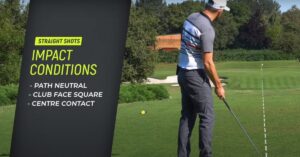How To Align Golf Grip Alignment (A Guide to Golf Grip Alignment)
The grip is the foundation of a golfer’s swing. It is the crucial connection between the player and the club, affecting the accuracy, control, and overall performance on the course. One aspect of grip that often goes overlooked is grip alignment.
To achieve proper grip alignment, start by placing the club handles diagonally across the fingers of your lead hand (left hand for right-handed golfers, right hand for left-handed golfers). The club’s shaft should run diagonally from the base of your pinky finger to the middle of your index finger.
In this comprehensive guide, we will provide you with valuable tips to help you achieve the perfect grip alignment for your game.
How To Align Golf Grip Alignment?

Aligning the grip of a golf club properly is essential for achieving a consistent and effective swing. Here’s a step-by-step guide on how to align your golf grip:
Step 1: Start with a Neutral Grip
Begin by assuming a neutral grip position. This means the “V” formed by the thumb and index finger of your lead hand (left hand for right-handed golfers, right hand for left-handed golfers) should be pointing towards your rear shoulder.
Step 2: Clubface Alignment
Before placing your trail hand on the club, align the clubface to your target. The leading edge of the clubface should be square to the target line. Visualize an imaginary line running straight from your target to the clubface.
Step 3: Position Lead Hand
Place your lead hand (left hand for right-handed golfers, right hand for left-handed golfers) on the grip. The lifeline of your lead hand should rest comfortably on top of the grip. The thumb should be pointing down the grip towards the clubhead.
Step 4: Overlap or Interlock Grip
Choose your preferred grip style – the overlap grip or the interlocking grip.
In the overlap grip, the pinky finger of your trail hand (right hand for right-handed golfers, left hand for left-handed golfers) rests on top of the gap between your lead hand’s index and middle finger.
In the interlock grip, the index finger of your lead hand and the pinky finger of your trail hand interlock.
Step 5: Position Trail Hand
Place your trail hand on the grip, completing the grip. The “V” formed by the thumb and index finger of your trail hand should also point towards your rear shoulder.
Step 6: Check Alignment
Take a moment to ensure the alignment of your grip. Both “V’s” formed by your lead and trail hands should point toward your rear shoulder. This promotes a square clubface at impact.
Step 7: Comfort and Tension
Finally, ensure that your grip feels comfortable and natural. Avoid excessive tension in your hands and fingers, as it can hinder your swing motion and control.
What Are Some Common Mistakes To Avoid When Aligning Your Golf Grip?

When aligning your golf grip, there are a few common mistakes that golfers often make. By being aware of these errors, you can avoid them and improve the effectiveness of your grip.
Here are some common mistakes to avoid:
Gripping Too Tightly
One of the most common mistakes is gripping the club too tightly. A tight grip can restrict your hand and wrist movement, leading to tension and a loss of feel and control. Aim for a relaxed and firm grip without excessive tension.
Gripping Too Much in the Palms
Another mistake is gripping the club too much in the palms of your hands. This can limit your ability to hinge the club properly during the swing and decrease your wrist action.
Instead, position the grip more in the fingers of your hands for better club control.
Misalignment of “V’s”
The “V’s” formed by your thumbs and index fingers play a crucial role in grip alignment.
One common mistake is having the “V” of the lead hand pointing too far left (for right-handed golfers) or too far right (for left-handed golfers).
This misalignment can lead to an open or closed clubface at impact. Ensure that the “V’s” point towards your rear shoulder for a square clubface.
Weak or Strong Grip
A weak grip occurs when both “V’s” point too far left (for right-handed golfers) or too far right (for left-handed golfers). This can result in a slice or a loss of power.
Conversely, a strong grip occurs when the “V’s” point too far right (for right-handed golfers) or too far left (for left-handed golfers), leading to hooks or pulls.
Strive for a neutral grip where the “V’s” point towards your rear shoulder.
Overlapping or Interlocking Incorrectly
If you use the overlap or interlock grip, make sure you interlock or overlap the correct fingers. Improper finger placement can affect your grip stability and control.
Practice the proper overlap or interlock grip technique to ensure a secure grip.
Neglecting Grip Size
Golfers often overlook the importance of grip size. Using too small or too large grips can affect your ability to control the club and may lead to inconsistency.
Experiment with different grip sizes to find the one that feels comfortable and suits your hand size.
Practice Drills for Developing Consistent Grip Alignment

Practicing drills designed to improve grip alignment can help develop consistency and ensure proper hand placement. Here are a few practice drills you can use to enhance your grip alignment:
Alignment Stick Drill
- Place an alignment stick or a golf club on the ground parallel to your target line.
- Set up in your address position with the club in your hands, focusing on your grip.
- Check that both “V’s” formed by your thumbs and index fingers are pointing towards your rear shoulder.
- Take slow and controlled practice swings, paying attention to maintaining proper grip alignment throughout the swing.
- The alignment stick provides a visual reference and helps you ingrain the correct hand positioning.
Mirror Check Drill
Stand in front of a mirror with a club in your hands as if you were addressing a ball.
Look at your grip alignment in the mirror, paying close attention to the position of the “V’s.”
Make any necessary adjustments to ensure both “V’s” point towards your rear shoulder.
Take practice swings while keeping your eyes on the mirror, verifying that your grip alignment remains consistent throughout the swing.
Thumb Placement Drill
During your practice swings or while hitting balls on the range, focus on the placement of your lead thumb (left thumb for right-handed golfers, right thumb for left-handed golfers).
Ensure that your lead thumb is positioned slightly to the right of the center of the grip (for right-handed golfers) or slightly to the left (for left-handed golfers).
This placement promotes a more neutral grip alignment and helps prevent the “V” of your lead hand from pointing too far left or right.
Grip Check Routine
- Develop a pre-shot routine that includes a quick grip check before each swing.
- Take a moment to visually inspect your grip alignment, ensuring that both “V’s” point towards your rear shoulder.
- This routine helps reinforce proper grip alignment and creates consistency in your hand placement.
Frequently Asked Questions
Here, we address common questions regarding hand placement and clubface alignment. Explore the answers below to refine your grip technique.
Is It Important To Check The Alignment Of The Clubface During Grip Setup?
Yes, it is crucial to ensure the clubface is square to the target. Use alignment guides on the club or visually check that the clubface is not closed or open at the address.
Should The Grip Pressure Be Firm Or Relaxed While Aligning The Golf Grip?
The grip pressure should be firm enough to maintain control but not overly tight. A balanced grip pressure allows for better feel and control during the swing.
Are There Any Grip Aids Or Training Tools Available For Improving Grip Alignment?
Yes, various grip aids and training tools can assist in achieving proper grip alignment. These tools can provide feedback and help develop muscle memory for a consistent grip.
How Often Should I Check And Adjust My Grip Alignment?
It is recommended to check your grip alignment regularly, especially if you notice inconsistencies in your shots. Making adjustments as needed will help maintain a proper grip alignment.
Can A Professional Golf Instructor Help In Improving Grip Alignment?
Absolutely. Seeking guidance from a professional golf instructor can be highly beneficial. They can assess your grip alignment, provide personalized advice, and offer drills to enhance your grip technique.
Conclusion
Mastering the alignment of your golf grip is essential for achieving consistent and accurate shots on the course.
Following the proper technique and ensuring that your hands are positioned correctly on the club can improve control, increase accuracy, and enhance your overall performance.
Practice diligently, and soon you’ll be reaping the benefits of a well-aligned grip in your golf game.






![How To Hang Golf Towel With Hole In Middle? [Complete Guide] how-to-hang-golf-towel-with-hole-in-middle](https://giftedgolfers.com/wp-content/uploads/2023/06/how-to-hang-golf-towel-with-hole-in-middle-300x157.jpg)